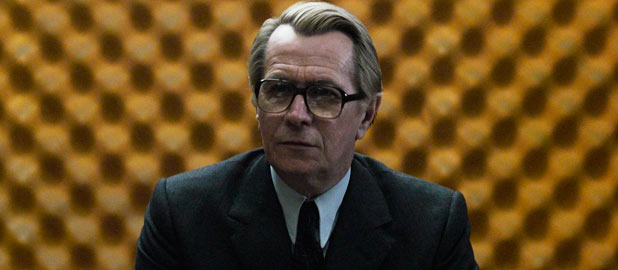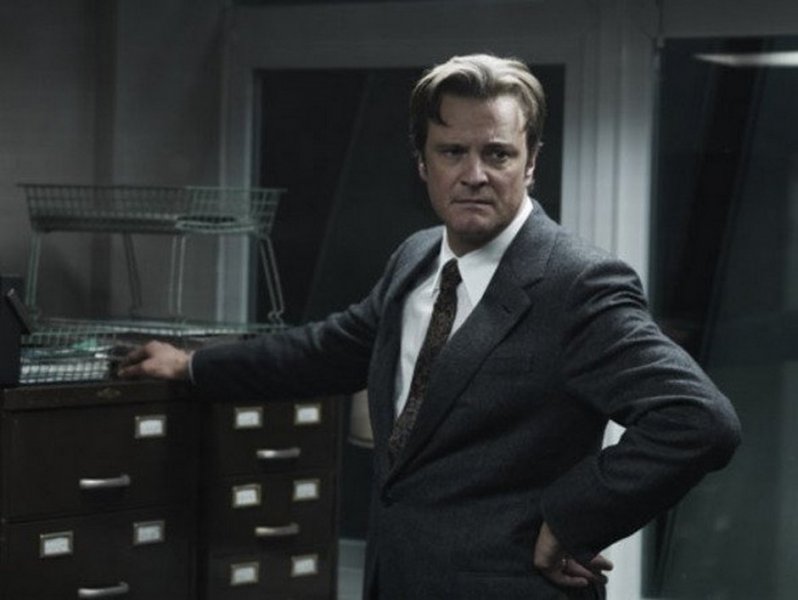|
Tinker Tailor Soldier
Spy
Reviewed
by
Damien Straker on
January 17th, 2011
Universal Pictures presents
a film directed by
Tomas
Alfredson
Screenplay
by
Bridget O'Connor and Peter Straughan, based on the novel 'Tinker Tailor
Soldier Spy' by John le Carre
Starring:
Gary Oldman, Colin Firth, John Hurt, Mark Strong, Toby Jones, Ciaran Hinds, Benedict
Cumberbatch and Tom Hardy
Running
Time:
127 mins
Rating:
MA
Released: January 19th,
2012
|
8/10
|
|
Tinker Tailor Soldier Spy is set in 1973, during the Cold War era in Britain. Two
elderly
men are being sacked from the head of MI6. They are George Smiley
(Gary
Oldman) and Control (John Hurt). Their dismissal comes from the bungle
of a
meeting a year earlier where Jim (Mark Strong) was meant to meet a
General who
would tell him the name of a Russian mole who has infiltrated British
intelligence. In flashback we discover that Jim was shot and left for
dead. In
the present day he has resumed his life, living in a caravan and
working as a
school teacher. When Control passes away, Smiley is asked to return to the
'Circus' to help track down the mole. Amidst some of the suspects are
Ricki (Tom
Hardy), Bill (Colin Firth), Peter (Benedict Cumberbatch), Roy (Ciaran
Hinds)
and Percy (Toby Jones), some of whom have been likened to the pieces on
a
chessboard by Control.

You will have to see Tinker,
Tailor, Soldier Spy twice. There are several reasons for this.
Foremost, it
is an impeccably made thriller from Tomas Alfredson, the Swedish
director who
gave us Let the Right One In (2008). This
is a director who knows how to tell
a story in what is sadly regarded as old fashioned terms. He is not
interested
in elaborate chase scenes or action sequences, but rather in building
tension
through selective pacing and a dense, compelling atmosphere. He was an
inspired
choice for this project because as he showed with his vampire epic, he
understands that less is more. He has focused a significant amount of
attention
on the film's set design. Many scenes are photographed from a wide
angle,
realising the high levels of detail in the film's mise-en-scène.
This
enhances the film's realism and authenticity because each room feels
tangible and involving, with a distinct amount of weight and gravitas.
This is
coupled with Alfredson's specificity of images, like the sweat on the
waiter's
brow dripping onto the table, to build an unbearable level of still,
burning
tension. The period looks and feels right too because the film doesn't
make a
point of it. It's shot in grainy, muted shades of brown and grey,
reminding us
that this is a period of control. The interior rooms are often lit with
deep
shadows over the faces of the actors, further contributing to overall
sense of
paranoia.
Many of these aesthetic devices make the film as chilling and
mesmerising as Let the Right One In. As a reward for this authenticity,
moments
of violence are more impacting and emotionally involving. There's some
upsetting vision of a mutilated corpse and a brief assassination but
Alfredson
refuses to linger over these moments. In terms of direction and
aesthetic
control, the film is faultless.

Thematically, this is a thriller of such breadth and
endless
complexity that you may not initially grasp how all of its intricate
stands
come together. This is assuming that, like myself, you have not read
the novel
or seen the BBC series. It is a challenge on an initial viewing but
what can be
drawn from the crux of the narrative is a series of anecdotes,
concerned with
the dissatisfaction of the British Empire. Smiley visits a woman he
used to
work with and she describes how the Second World War was the last
honourable
moment for British intelligence. There is also a riveting story of how
Smiley
tried to convince a man to return to their side but he was more content
with
returning to Russia to die. Equally fascinating is to consider the film
in
regards to generational change. Throughout the film Smiley is
photographed
swimming with old men and Control's sudden death is an ominous reminder
that he
is at the end of his run, forced out by much younger men too. We learn
that his
wife Anne left him because she was having an affair with someone
younger, which
also raises questions of loyalty, addressed in the film's plausible
revelation.
On loyalty, one of the best scenes in the film sees Peter returning to
the
circus to steal a file for Smiley. It has one of the most unforgettable
long
shots in cinema: the glass windows of an entire office, along with each
floor,
placed into the one frame. True to a lot of the film, it's a gripping
scene for
what it implies, rather than what eventuates through action. It almost
breaks Peter,
having to spy on his own people. For as many of those who are
displeased with
the Empire, there are still those who want to believe in it. The entire
cast is
well chosen, charismatic and sometimes funny too. They give us reasons
to feel
for these men. I like that they chose distinct British actors who are
easy to
recognise too. Oldman, even with minimal dialogue, strikes a visible
level of
intensity in his quiet work. Through the most ordinary lines like,
'Then what
happened?', he has an affirming grip on his character. Firth is another
standout, this time playing against type and he's terrific. Although I
am still
not confident in how many of the storylines come together it is a
testament to
the filmmaking and the performance that I'd like to see the film again
to find
out.
|